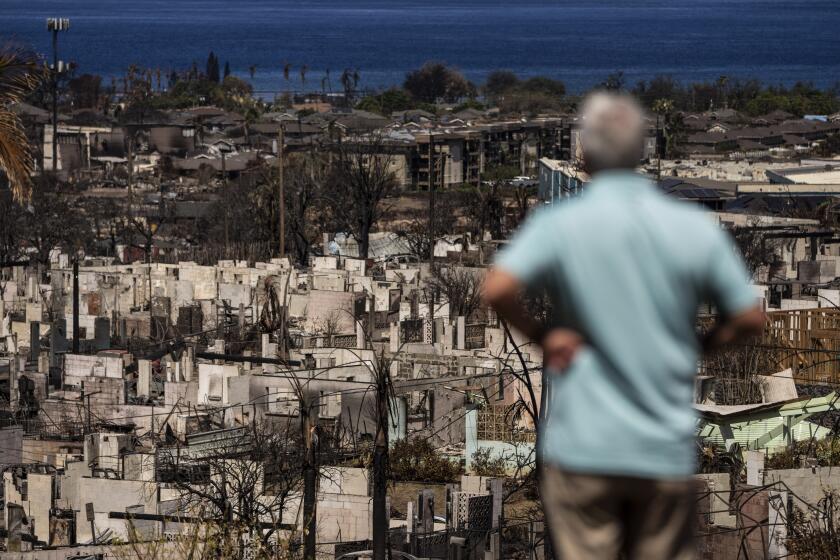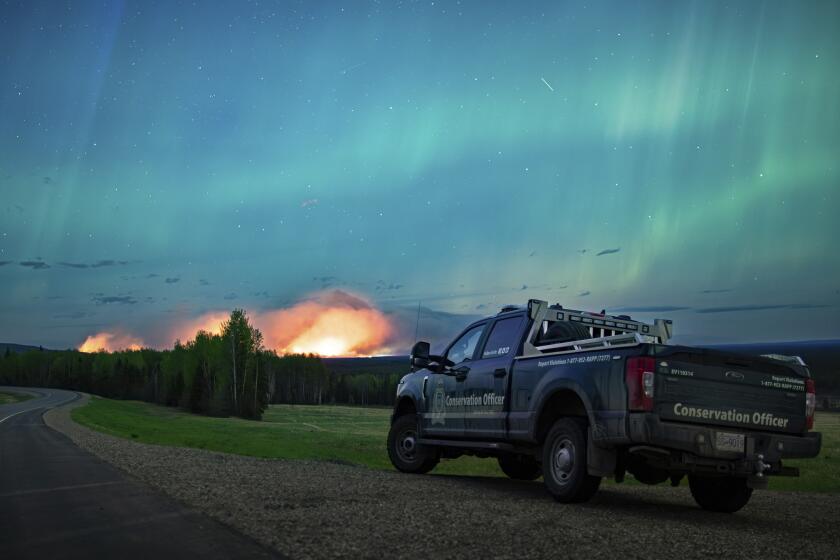Ex-Fullerton Chief Fighting New Kind of Fire
Two years ago when he was still chief of the Fullerton Fire Department, Ron Coleman had a wacky idea.
The Orange County Burn Assn. needed money. So Coleman, now 51, came up with a plan: Why not have a firefighter spend 24 hours atop a tall ladder in a shopping mall to inspire shoppers to donate their coins?
The scheme worked.
“It made a significant change in the financial status of the burn association,” said Marc Martin, the department’s operations chief. And Coleman emerged as “kind of the P.T. Barnum of the fire service.”
Coleman will have plenty more opportunities to exhibit his economic creativity during the next few years. Last month, he became the state’s new fire marshal, an $83,868-a-year position from which he will be responsible for enforcing fire-related laws, investigating arson fires, providing training and education for all state fire service personnel, approving fire alarm systems and gathering statewide statistical data on fires and burns.
But one of his most pressing tasks, Coleman said during a recent telephone interview from his Sacramento office, will be to help local fire departments learn how to operate during tight economic times. “It’s safe to say that the total amount of resources available for fire protection are less today than they were five years ago,” he said, adding that many local fire departments in California have experienced budget reductions of 5% to 10% during the past two years.
Coleman’s prescription: economize by enhancing cooperation between various firefighting agencies, improve communication among those in the field, and ultimately coordinate efforts to provide services more efficiently.
Those responsible for Coleman’s appointment believe he has a background uniquely suited to that task.
A lifelong Orange County resident, he began his career as a firefighter with the U.S. Forest Service in Trabuco Canyon. In 1962, he signed on with the Costa Mesa Fire Department where he eventually became operations chief. More than a decade later, he transferred to the San Clemente Fire Department as chief, and for the past six years has served as chief in Fullerton.
Colleagues in Fullerton remember Coleman as a hard-working, innovative leader whose office was constantly strewn with debris from the myriad of projects he was involved in.
“Working with Ron was like being on a fast train and trying to keep up with it all the time,” recalled Mike Parker, a battalion chief. “He’s an interesting individual and anybody who works with him is going to learn a lot about firefighting.”
Irma Gullickson, Coleman’s secretary for the past three years, commended her former boss for his “fun” attitude. “He was thought of as a progressive chief,” she said. “He was very forward-thinking, very future-oriented. He looked at the big picture.”
Often that big picture compelled the chief to get involved in public projects.
In 1979, disturbed by what he viewed as unnecessary deaths in residential fires, Coleman was instrumental in persuading San Clemente to become the first U.S. city to mandate ceiling sprinklers in all new residences. Other cities eventually followed suit, including at least 18 in Southern California.
Fullerton colleagues credit him with opening up the department’s channels of communication by bringing front-line firefighters into the decision-making process. Among other things, they say, he pioneered the use of video by creating a basement studio at department headquarters from which information can be broadcast to local fire stations.
And as past president of both the International Assn. of Fire Chiefs and the Orange County Fire Chiefs Assn., the new fire marshal is in a unique position to utilize personal relationships in coordinating services with an eye toward saving money and increasing efficiency, said Andrew Poat, undersecretary of the State and Consumer Services Agency and Coleman’s boss.
“His reputation for being able to work with and bring together various elements of the fire-safety community,” Poat said, is unsurpassed. “Fire services are one area in which we can achieve some efficiencies; Ron agrees and this is one of the first areas he will be looking into.”
Not everyone is an unadulterated fan, however.
During his tenure in Fullerton, Coleman’s high visibility as a spokesman for various fire-related organizations often kept him on the road, causing some city officials to complain that he was inaccessible.
Most colleagues, however, see him as a firefighter’s firefighter.
Dispatchers working during his administration say they were under standing orders to call the chief at home anytime there was a significant conflagration, day or night. Dressed in his civvies, Coleman would invariably show up to stand unobtrusively in the background snapping photographs for his vast collection of blaze-related souvenirs and artifacts.
The collection is an outgrowth of the chief’s lifelong fascination with fires and the people who fight them. In addition to the thousands of photographs, it includes a warehouse full of antique firefighting equipment such as helmets, hose carts and other historical paraphernalia. It also includes an array of antique toy firetrucks, a subject about which he has written two books.
And, always the fire buff, the chief spent most of his vacations visiting other fire departments around the country getting ideas on how to better run his own.
“He’s a real enthusiast,” Martin said. “He enjoys his profession so thoroughly that it’s also his hobby.”
More to Read
Start your day right
Sign up for Essential California for news, features and recommendations from the L.A. Times and beyond in your inbox six days a week.
You may occasionally receive promotional content from the Los Angeles Times.






